#!/usr/bin/env python
# coding: utf-8
# # Overview of the base class structure
#
# `aeon` uses a core inheritance hierarchy of classes across the toolkit, with
# specialised sub classes in each module. The basic class hierarchy is summarised in
# the following simplified UML
#
#  #
# ## sklearn `BaseEstimator` and aeon `BaseObject`
#
# To make sense of this, we break it down from the top.
#
#
#
# ## sklearn `BaseEstimator` and aeon `BaseObject`
#
# To make sense of this, we break it down from the top.
#
#  #
# Everything inherits from sklearns `BaseEstimator`. This handles the mechanisms for
# getting and setting parameters. The code structure below is stylised to show the
# main functionality and may differ in details from the actual implementations.
#
#
#
# Everything inherits from sklearns `BaseEstimator`. This handles the mechanisms for
# getting and setting parameters. The code structure below is stylised to show the
# main functionality and may differ in details from the actual implementations.
#
# 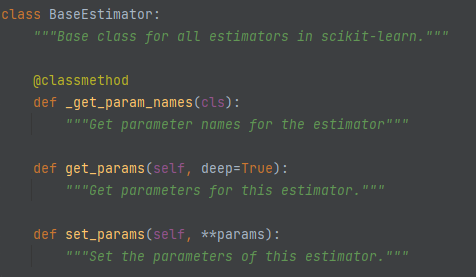 #
# The aeon class `BaseObject` extends `BaseEstimator` and adds the tagging method and
# some other functionality used in `aeon` estimators
#
#
#
# The aeon class `BaseObject` extends `BaseEstimator` and adds the tagging method and
# some other functionality used in `aeon` estimators
#
#  #
# ## aeons ``BaseEstimator``, `BaseDeepNetwork` and `BaseMetric`
#
# Three classes extend `BaseObject`: ``BaseEstimator``, `BaseDeepNetwork` and
# `BaseMetric`.
#
# `BaseDeepNetwork` is the base class for all the deep learning networks defined in the
# `networks` module. It has a single abstract method `build_network`.
#
#
#
# ## aeons ``BaseEstimator``, `BaseDeepNetwork` and `BaseMetric`
#
# Three classes extend `BaseObject`: ``BaseEstimator``, `BaseDeepNetwork` and
# `BaseMetric`.
#
# `BaseDeepNetwork` is the base class for all the deep learning networks defined in the
# `networks` module. It has a single abstract method `build_network`.
#
#  #
# The `BaseMetric` class is the base class for forecasting performance metrics. It has
# a single abstract method `evaluate`.
#
#
#
# The `BaseMetric` class is the base class for forecasting performance metrics. It has
# a single abstract method `evaluate`.
#
#  #
# The ``BaseEstimator`` class is the base class for the majority of classes in aeon.
# Anything that uses fit and predict in aeon. It contains a protected attribute
# `_is_fitted` and checks as to the value of this attribute. It also has a method to
# get fitted parameters.
#
#
#
# The ``BaseEstimator`` class is the base class for the majority of classes in aeon.
# Anything that uses fit and predict in aeon. It contains a protected attribute
# `_is_fitted` and checks as to the value of this attribute. It also has a method to
# get fitted parameters.
#
# 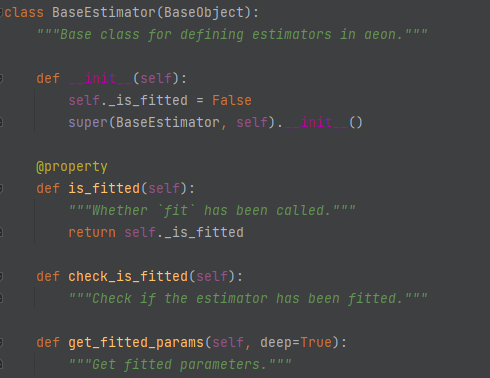 # `BaseEstimator` has four direct base classes: `BaseForecaster`,
# `BaseSeriesAnnotator`, `BaseTransformer` and `BaseCollectionEstimator`.
#
#
#
# `BaseEstimator` has four direct base classes: `BaseForecaster`,
# `BaseSeriesAnnotator`, `BaseTransformer` and `BaseCollectionEstimator`.
#
#
#  # ## `BaseForecaster` (aeon.forecasting.base)
# contains the forecasting specific methods. More details are available in the [API](https://www.aeon-toolkit.org/en/latest/api_reference/forecasting.html). `BaseForecaster` has the following concrete methods:
#
#
# ## `BaseForecaster` (aeon.forecasting.base)
# contains the forecasting specific methods. More details are available in the [API](https://www.aeon-toolkit.org/en/latest/api_reference/forecasting.html). `BaseForecaster` has the following concrete methods:
#
# 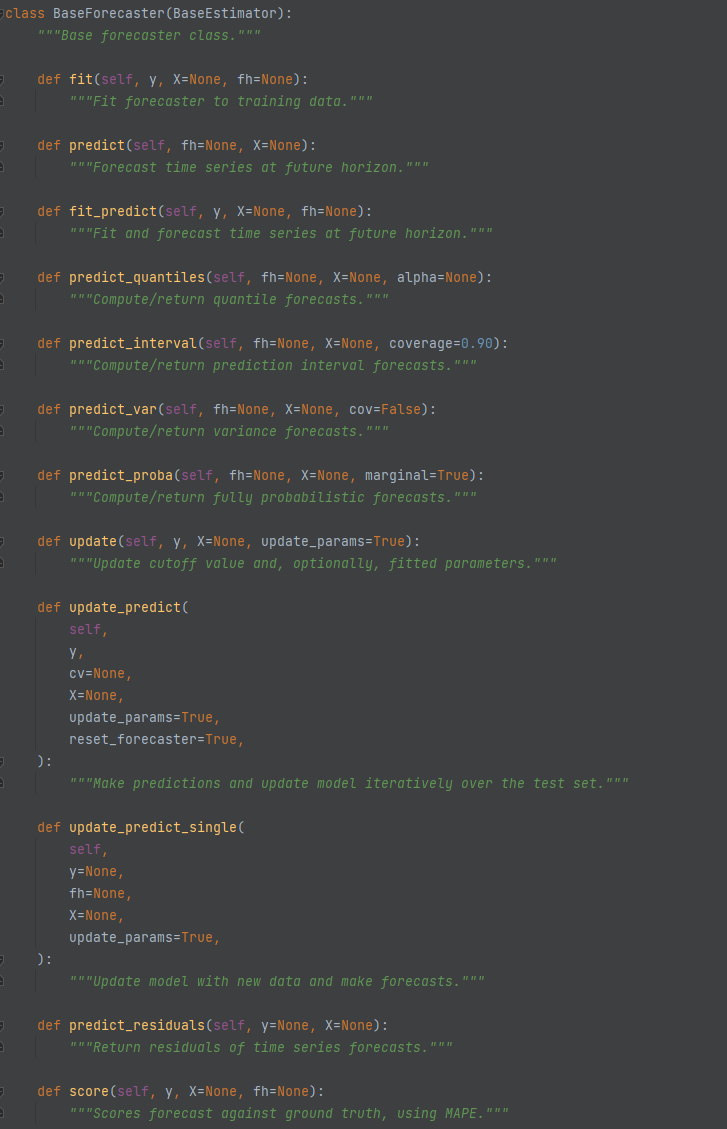 # ## `BaseSeriesAnnotator` (aeon.annotation.base)
#
# is a largely experimental base class for use with annotators that implement
# techniques for segmentation and anomaly detection. It has two public attributes: `fmt`
# and `labels`, and public methods as follows:
#
#
# ## `BaseSeriesAnnotator` (aeon.annotation.base)
#
# is a largely experimental base class for use with annotators that implement
# techniques for segmentation and anomaly detection. It has two public attributes: `fmt`
# and `labels`, and public methods as follows:
#
#  # ## `BaseTransformer` (aeon.transformations.base)
#
# Is the base class for all transformers, including single series transformers and
# collections transformers.
#
#
# ## `BaseTransformer` (aeon.transformations.base)
#
# Is the base class for all transformers, including single series transformers and
# collections transformers.
#
# 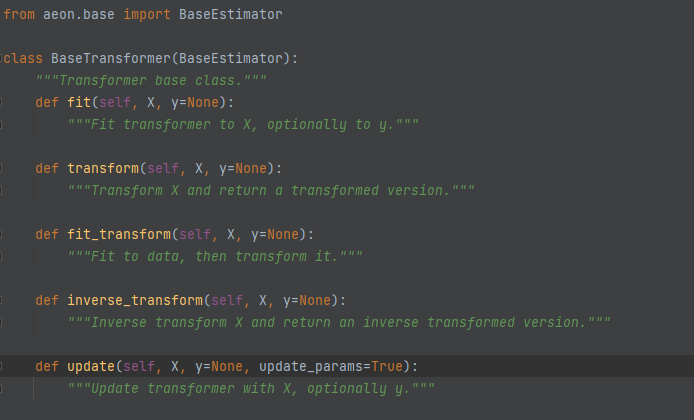 #
# ## `BaseCollectionEstimator` (aeon.base)
#
# Is the base class for estimators that construct models on collections of time series.
# This includes classifiers, clusterers, regressors and collection transformers. It
# contains attributes and tags common to all these estimators, and protected methods
# to perform checks and preprocessing common to all these estimators.
#
#
#
# ## `BaseCollectionEstimator` (aeon.base)
#
# Is the base class for estimators that construct models on collections of time series.
# This includes classifiers, clusterers, regressors and collection transformers. It
# contains attributes and tags common to all these estimators, and protected methods
# to perform checks and preprocessing common to all these estimators.
#
#  # The subclasses of `BaseCollectionEstimator` are as follows
#
#
# The subclasses of `BaseCollectionEstimator` are as follows
#
#  #
# they have similar interfaces, but they are not identical
#
# ## `BaseClassifier` (aeon.classification)
#
# This is the base class for all classifiers. It uses the standard `fit`, `predict` and
# `predict_proba` structure from `sklearn`. `fit` and
# `predict` call the abstract methods `_fit` and `_predict` which are implemented in
# the subclass to define the classification algorithm. All of the common format checking
# and conversion is done using the following final methods defined in
# `BaseCollectionEstimator`.
#
#
#
# they have similar interfaces, but they are not identical
#
# ## `BaseClassifier` (aeon.classification)
#
# This is the base class for all classifiers. It uses the standard `fit`, `predict` and
# `predict_proba` structure from `sklearn`. `fit` and
# `predict` call the abstract methods `_fit` and `_predict` which are implemented in
# the subclass to define the classification algorithm. All of the common format checking
# and conversion is done using the following final methods defined in
# `BaseCollectionEstimator`.
#
#  # ## `BaseRegressor` (aeon.regression)
#
# BaseRegressor has the same structure as `BaseClassifier`, although it has no
# `predict_proba` method. The tests on y are also different.
#
#
#
# ## `BaseRegressor` (aeon.regression)
#
# BaseRegressor has the same structure as `BaseClassifier`, although it has no
# `predict_proba` method. The tests on y are also different.
#
#
# 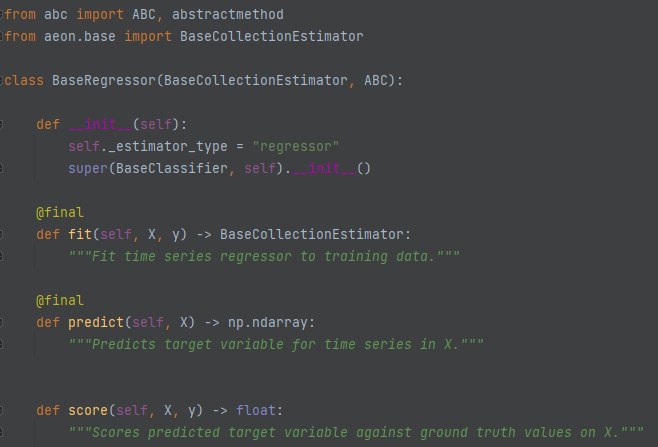 # ## `BaseClusterer` (aeon.clustering)
#
# `BaseClusterer` also has `fit` and `predict`, but does not take input y. It does
# include `predict_proba`.
#
#
#
# ## `BaseClusterer` (aeon.clustering)
#
# `BaseClusterer` also has `fit` and `predict`, but does not take input y. It does
# include `predict_proba`.
#
#
#  # ## `BaseCollectionTransformer` (aeon.transformations.collection)
#
# The `BaseCollectionTransformer` was introduced to differentiate transformers that
# work on a single series to those that work on collections. Part of the motivation was
# to work around a lot of legacy code in `BaseTransformer` that performs a huge amount
# of conversion checks that is unnecessary for collections. Rather than `fit` and
# `predict` it implements `fit`, `transform` and `fit_transform`.
#
#
#
# ## `BaseCollectionTransformer` (aeon.transformations.collection)
#
# The `BaseCollectionTransformer` was introduced to differentiate transformers that
# work on a single series to those that work on collections. Part of the motivation was
# to work around a lot of legacy code in `BaseTransformer` that performs a huge amount
# of conversion checks that is unnecessary for collections. Rather than `fit` and
# `predict` it implements `fit`, `transform` and `fit_transform`.
#
#
#  #
#
#
#
 #
# ## sklearn `BaseEstimator` and aeon `BaseObject`
#
# To make sense of this, we break it down from the top.
#
#
#
# ## sklearn `BaseEstimator` and aeon `BaseObject`
#
# To make sense of this, we break it down from the top.
#
#  #
# Everything inherits from sklearns `BaseEstimator`. This handles the mechanisms for
# getting and setting parameters. The code structure below is stylised to show the
# main functionality and may differ in details from the actual implementations.
#
#
#
# Everything inherits from sklearns `BaseEstimator`. This handles the mechanisms for
# getting and setting parameters. The code structure below is stylised to show the
# main functionality and may differ in details from the actual implementations.
#
#  #
# The aeon class `BaseObject` extends `BaseEstimator` and adds the tagging method and
# some other functionality used in `aeon` estimators
#
#
#
# The aeon class `BaseObject` extends `BaseEstimator` and adds the tagging method and
# some other functionality used in `aeon` estimators
#
#  #
# ## aeons ``BaseEstimator``, `BaseDeepNetwork` and `BaseMetric`
#
# Three classes extend `BaseObject`: ``BaseEstimator``, `BaseDeepNetwork` and
# `BaseMetric`.
#
# `BaseDeepNetwork` is the base class for all the deep learning networks defined in the
# `networks` module. It has a single abstract method `build_network`.
#
#
#
# ## aeons ``BaseEstimator``, `BaseDeepNetwork` and `BaseMetric`
#
# Three classes extend `BaseObject`: ``BaseEstimator``, `BaseDeepNetwork` and
# `BaseMetric`.
#
# `BaseDeepNetwork` is the base class for all the deep learning networks defined in the
# `networks` module. It has a single abstract method `build_network`.
#
#  #
# The `BaseMetric` class is the base class for forecasting performance metrics. It has
# a single abstract method `evaluate`.
#
#
#
# The `BaseMetric` class is the base class for forecasting performance metrics. It has
# a single abstract method `evaluate`.
#
#  #
# The ``BaseEstimator`` class is the base class for the majority of classes in aeon.
# Anything that uses fit and predict in aeon. It contains a protected attribute
# `_is_fitted` and checks as to the value of this attribute. It also has a method to
# get fitted parameters.
#
#
#
# The ``BaseEstimator`` class is the base class for the majority of classes in aeon.
# Anything that uses fit and predict in aeon. It contains a protected attribute
# `_is_fitted` and checks as to the value of this attribute. It also has a method to
# get fitted parameters.
#
#  # `BaseEstimator` has four direct base classes: `BaseForecaster`,
# `BaseSeriesAnnotator`, `BaseTransformer` and `BaseCollectionEstimator`.
#
#
#
# `BaseEstimator` has four direct base classes: `BaseForecaster`,
# `BaseSeriesAnnotator`, `BaseTransformer` and `BaseCollectionEstimator`.
#
#
#  # ## `BaseForecaster` (aeon.forecasting.base)
# contains the forecasting specific methods. More details are available in the [API](https://www.aeon-toolkit.org/en/latest/api_reference/forecasting.html). `BaseForecaster` has the following concrete methods:
#
#
# ## `BaseForecaster` (aeon.forecasting.base)
# contains the forecasting specific methods. More details are available in the [API](https://www.aeon-toolkit.org/en/latest/api_reference/forecasting.html). `BaseForecaster` has the following concrete methods:
#
#  # ## `BaseSeriesAnnotator` (aeon.annotation.base)
#
# is a largely experimental base class for use with annotators that implement
# techniques for segmentation and anomaly detection. It has two public attributes: `fmt`
# and `labels`, and public methods as follows:
#
#
# ## `BaseSeriesAnnotator` (aeon.annotation.base)
#
# is a largely experimental base class for use with annotators that implement
# techniques for segmentation and anomaly detection. It has two public attributes: `fmt`
# and `labels`, and public methods as follows:
#
#  # ## `BaseTransformer` (aeon.transformations.base)
#
# Is the base class for all transformers, including single series transformers and
# collections transformers.
#
#
# ## `BaseTransformer` (aeon.transformations.base)
#
# Is the base class for all transformers, including single series transformers and
# collections transformers.
#
#  #
# ## `BaseCollectionEstimator` (aeon.base)
#
# Is the base class for estimators that construct models on collections of time series.
# This includes classifiers, clusterers, regressors and collection transformers. It
# contains attributes and tags common to all these estimators, and protected methods
# to perform checks and preprocessing common to all these estimators.
#
#
#
# ## `BaseCollectionEstimator` (aeon.base)
#
# Is the base class for estimators that construct models on collections of time series.
# This includes classifiers, clusterers, regressors and collection transformers. It
# contains attributes and tags common to all these estimators, and protected methods
# to perform checks and preprocessing common to all these estimators.
#
#  # The subclasses of `BaseCollectionEstimator` are as follows
#
#
# The subclasses of `BaseCollectionEstimator` are as follows
#
#  #
# they have similar interfaces, but they are not identical
#
# ## `BaseClassifier` (aeon.classification)
#
# This is the base class for all classifiers. It uses the standard `fit`, `predict` and
# `predict_proba` structure from `sklearn`. `fit` and
# `predict` call the abstract methods `_fit` and `_predict` which are implemented in
# the subclass to define the classification algorithm. All of the common format checking
# and conversion is done using the following final methods defined in
# `BaseCollectionEstimator`.
#
#
#
# they have similar interfaces, but they are not identical
#
# ## `BaseClassifier` (aeon.classification)
#
# This is the base class for all classifiers. It uses the standard `fit`, `predict` and
# `predict_proba` structure from `sklearn`. `fit` and
# `predict` call the abstract methods `_fit` and `_predict` which are implemented in
# the subclass to define the classification algorithm. All of the common format checking
# and conversion is done using the following final methods defined in
# `BaseCollectionEstimator`.
#
#  # ## `BaseRegressor` (aeon.regression)
#
# BaseRegressor has the same structure as `BaseClassifier`, although it has no
# `predict_proba` method. The tests on y are also different.
#
#
#
# ## `BaseRegressor` (aeon.regression)
#
# BaseRegressor has the same structure as `BaseClassifier`, although it has no
# `predict_proba` method. The tests on y are also different.
#
#
#  # ## `BaseClusterer` (aeon.clustering)
#
# `BaseClusterer` also has `fit` and `predict`, but does not take input y. It does
# include `predict_proba`.
#
#
#
# ## `BaseClusterer` (aeon.clustering)
#
# `BaseClusterer` also has `fit` and `predict`, but does not take input y. It does
# include `predict_proba`.
#
#
#  # ## `BaseCollectionTransformer` (aeon.transformations.collection)
#
# The `BaseCollectionTransformer` was introduced to differentiate transformers that
# work on a single series to those that work on collections. Part of the motivation was
# to work around a lot of legacy code in `BaseTransformer` that performs a huge amount
# of conversion checks that is unnecessary for collections. Rather than `fit` and
# `predict` it implements `fit`, `transform` and `fit_transform`.
#
#
#
# ## `BaseCollectionTransformer` (aeon.transformations.collection)
#
# The `BaseCollectionTransformer` was introduced to differentiate transformers that
# work on a single series to those that work on collections. Part of the motivation was
# to work around a lot of legacy code in `BaseTransformer` that performs a huge amount
# of conversion checks that is unnecessary for collections. Rather than `fit` and
# `predict` it implements `fit`, `transform` and `fit_transform`.
#
#
#  #
#
#
#